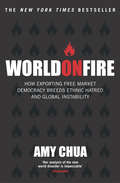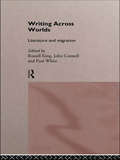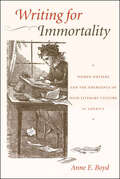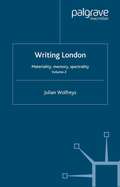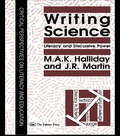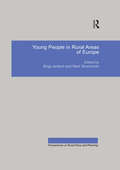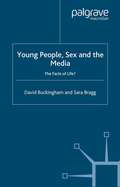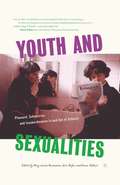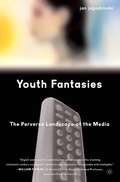- Table View
- List View
Working Images: Visual Research and Representation in Ethnography
by Ana Isabel Alfonso Laszlo Kurti Sarah PinkVisual methods such as drawing, painting, video, photography and hypermedia offer increasingly accessible and popular resources for ethnographic research. In Working Images, prominent visual anthropologists and artists explore how old and new visual media can be integrated into contemporary forms of research and representation. Drawing upon projects undertaken both 'at home' in their native countries and abroad in locations such as Ethopia and Venezuela, the book's contributors demonstrate how visual methods are used in the field, and how these methods can produce and communicate knowledge about our own and other cultures. As well as focusing on key issues such as ethics and the relationship between word and image, they emphasize the huge range of visual methods currently opening up new possibilities for field research, from cartoons and graphic art to new media such as digital video and online technologies.
Working Images: Visual Research and Representation in Ethnography
by Sarah Pink László Kürti Ana Isabel AfonsoVisual methods such as drawing, painting, video, photography and hypermedia offer increasingly accessible and popular resources for ethnographic research. In Working Images, prominent visual anthropologists and artists explore how old and new visual media can be integrated into contemporary forms of research and representation. Drawing upon projects undertaken both 'at home' in their native countries and abroad in locations such as Ethopia and Venezuela, the book's contributors demonstrate how visual methods are used in the field, and how these methods can produce and communicate knowledge about our own and other cultures. As well as focusing on key issues such as ethics and the relationship between word and image, they emphasize the huge range of visual methods currently opening up new possibilities for field research, from cartoons and graphic art to new media such as digital video and online technologies.
Working Method: Research and Social Justice (Critical Social Thought)
by Lois Weis Michelle FineWorking Method focuses on the theory, method, and politics of contemporary social research. As ethnographic and qualitative research become more popular, noted scholars Weis and Fine provide a roadmap for understanding the complexities involved in doing this research.
Working Method: Research and Social Justice (Critical Social Thought)
by Lois Weis Michelle FineWorking Method focuses on the theory, method, and politics of contemporary social research. As ethnographic and qualitative research become more popular, noted scholars Weis and Fine provide a roadmap for understanding the complexities involved in doing this research.
World On Fire: How Exporting Free Market Democracy Breeds Ethnic Hatred And Global Instability
by Amy ChuaAmy Chua's remarkable and provocative book explores the tensions of the post-Cold War globalising world. As global markets open, ethnic conflict worsens and democracy in developing nations can turn ugly and violent. Chua shows how free markets have concentrated disproportionate, often spectacular wealth in the hands of resented ethnic minorities - 'market-dominant minorities'. Adding democracy to this volatile mix can unleash suppressed ethnic hatred and bring to power 'ethno-nationalist' governments that pursue aggressive policies of confiscation and revenge. Chua also shows how individual countries may be viewed as market-dominant minorities, a fact that could help to explain the rising tide of anti-American sentiment around the world and the visceral hatred of Americans expressed in recent acts of terrorism. Chua is not an anti-globalist. But in this must-read bestselling book she presciently warns that, far from making the world a better and safer place, democracy and capitalism - at least in the raw, unrestrained form in which they are currently being exported - are intensifying ethnic resentment and global violence, with potentially catastrophic results.
World Poverty: A Reference Handbook (Contemporary World Issues)
by Geoffrey GilbertWorld Poverty provides an authoritative and balanced examination of the many facets of world poverty and the policy issues surrounding it.World Poverty: A Reference Handbook provides an authoritative overview of world poverty as it stands today. Economic expert Geoffrey Gilbert offers a balanced examination of the controversies and policies surrounding world poverty and addresses such fundamental issues as the definition of poverty and the construction of indicators and indices.In clear terms, this reference work sheds light on spatial patterns of poverty around the globe; the quality of health, food, shelter; and the commitments of the international community. Issues of special interest such as globalization, effectiveness of foreign aid, corruption, and goals for poverty reduction are presented from diverse angles. As with all volumes in the series, this essential reference includes biographical profiles, pivotal documents, and detailed listings of organizations and resources.
The Wounds of Exclusion: Poverty, Women’s Health, and Social Justice (International Institute for Qualitative Methodology Series)
by Colleen ReidThis participant observer study chronicles the stories of a group of poor Canadian women, their experience with exclusion by health and social service providers, and their involvement in a feminist action research project.
The Wounds of Exclusion: Poverty, Women’s Health, and Social Justice (International Institute for Qualitative Methodology Series)
by Colleen ReidThis participant observer study chronicles the stories of a group of poor Canadian women, their experience with exclusion by health and social service providers, and their involvement in a feminist action research project.
Writing Across Worlds: Literature and Migration
by Russell King John Connell Paul WhiteInternational migration has long been a dominant feature of world literature from both post-industrial and developing countries. The increasing demands of the global economic system and continued political instability in many of the world's region have highlighted this shifting map of the world's peoples.Yet, political concern for the larger scale economic and social impact of migration has effectively obscured the nature of the migratory nature of the migratory experience itself, the emotions and practicalities of departure, travel, arrival and the attempt to rebuild a home.Writing Across Worlds explores an extraordinary range of migration literaturesm from letters and diaries to journalistic articles, autobiographies and fiction, in order to analyse the reality of the migrant's experience. The sheer range of writings - Irish, Friulian, Italian, Jewish and South Asian British, Gastarbeiter literature from Germany, Pied noir, French-Algerian and French West Indian writing, Carribbean novels, Slovene emigrant texts, Japanese-Canadian writing, migration in American novels, narratives from Australia, South Africa, Samoa and others - illustrate the diversity of global migratory experience and emphasise the social context of literature.The geographic and literary range of Writing Across Worlds makes this collection an invaluable analysis of migration, giving voice to the hope, pain, nostalgia and triumph of lives lived in other places.
Writing Across Worlds: Literature and Migration
by John Connell Russell King Paul WhiteInternational migration has long been a dominant feature of world literature from both post-industrial and developing countries. The increasing demands of the global economic system and continued political instability in many of the world's region have highlighted this shifting map of the world's peoples.Yet, political concern for the larger scale economic and social impact of migration has effectively obscured the nature of the migratory nature of the migratory experience itself, the emotions and practicalities of departure, travel, arrival and the attempt to rebuild a home.Writing Across Worlds explores an extraordinary range of migration literaturesm from letters and diaries to journalistic articles, autobiographies and fiction, in order to analyse the reality of the migrant's experience. The sheer range of writings - Irish, Friulian, Italian, Jewish and South Asian British, Gastarbeiter literature from Germany, Pied noir, French-Algerian and French West Indian writing, Carribbean novels, Slovene emigrant texts, Japanese-Canadian writing, migration in American novels, narratives from Australia, South Africa, Samoa and others - illustrate the diversity of global migratory experience and emphasise the social context of literature.The geographic and literary range of Writing Across Worlds makes this collection an invaluable analysis of migration, giving voice to the hope, pain, nostalgia and triumph of lives lived in other places.
Writing for Immortality: Women and the Emergence of High Literary Culture in America
by Anne E. BoydBefore the Civil War, American writers such as Catharine Maria Sedgwick and Harriet Beecher Stowe had established authorship as a respectable profession for women. But though they had written some of the most popular and influential novels of the century, they accepted the taboo against female writers, regarding themselves as educators and businesswomen. During and after the Civil War, some women writers began to challenge this view, seeing themselves as artists writing for themselves and for posterity.Writing for Immortality studies the lives and works of four prominent members of the first generation of American women who strived for recognition as serious literary artists: Louisa May Alcott, Elizabeth Stuart Phelps, Elizabeth Stoddard, and Constance Fenimore Woolson. Combining literary criticism and cultural history, Anne E. Boyd examines how these authors negotiated the masculine connotation of "artist," imagining a space for themselves in the literary pantheon. Redrawing the boundaries between male and female literary spheres, and between American and British literary traditions, Boyd shows how these writers rejected the didacticism of the previous generation of women writers and instead drew their inspiration from the most prominent "literary" writers of their day: Emerson, James, Barrett Browning, and Eliot.Placing the works and experiences of Alcott, Phelps, Stoddard, and Woolson within contemporary discussions about "genius" and the "American artist," Boyd reaches a sobering conclusion. Although these women were encouraged by the democratic ideals implicit in such concepts, they were equally discouraged by lingering prejudices about their applicability to women.
Writing London: Volume 2: Materiality, Memory, Spectrality
by J. WolfreysFollowing on from Julian Wolfrey's successful Writing London (1998), this second volume extends Wolfrey's original argument that a new urban sensibility in the nineteenth century had been developed which established new ways of writing about and responding to the city. Writing London - Volume 2 explores through a range of readings of twentieth-century films and texts the complex relationship between the experience of the city, the pleasures of the urban text and the solitary nature of these pleasures. The book has a broad focus, in part dictated not only by the transformation of literary production in the twentieth-century, but also by the need to respond to the changes in both urban representation and London itself. Writers discussed include Virginia Woolf, Elizabeth Bowen, Maureen Duffy, Peter Ackroyd, Iain Sinclair and Michael Moorcock. The volume covers texts from the late nineteenth-century to the end of the twentieth, in a critical reading that incorporates the theoretical insights of Walter Benjamin, Guy Debord and Jacques Derrida.
Writing Science: Literacy And Discursive Power (Pitt Comp Literacy Culture Ser.)
by M.A.K. Halliday J.R. MartinThis book is about the use of language in the science classroom. It discusses the evolution of scientific discourse for learning in secondary schools, and examines the form and function of language across a variety of levels including lexiogrammar, discourse semantics, register, genre and ideology. Special attention is paid to how this knowledge is imparted. It will be of particular interest to educators involved with linguistics and/or science curriculum and teachers of English for special and academic purposes.; It is aimed at teachers of undergraduates in science and literacy, linguists teaching in English for special and academic purposes and students in higher education with an interest in science and literacy.
Writing Science: Literacy And Discursive Power
by M.A.K. Halliday J.R. MartinThis book is about the use of language in the science classroom. It discusses the evolution of scientific discourse for learning in secondary schools, and examines the form and function of language across a variety of levels including lexiogrammar, discourse semantics, register, genre and ideology. Special attention is paid to how this knowledge is imparted. It will be of particular interest to educators involved with linguistics and/or science curriculum and teachers of English for special and academic purposes.; It is aimed at teachers of undergraduates in science and literacy, linguists teaching in English for special and academic purposes and students in higher education with an interest in science and literacy.
The Xavante in Transition: Health, Ecology, and Bioanthropology in Central Brazil (Human-Environment Interactions)
by Carlos E. Coimbra Nancy M. Flowers Francisco M. Salzano Ricardo V. SantosThe Xavánte in Transition presents a diachronic view of the long and complex interaction between the Xavánte, an indigenous people of the Brazilian Amazon, and the surrounding nation, documenting the effects of this interaction on Xavánte health, ecology, and biology. A powerful example of how a small-scale society, buffeted by political and economic forces at the national level and beyond, attempts to cope with changing conditions, this study will be important reading for demographers, economists, environmentalists, and public health workers. ". . . an integrated and politically informed anthropology for the new millennium. They show how the local and the regional meet on the ground and under the skin." --Alan H. Goodman, Professor of Biological Anthropology, Hampshire College "This volume delivers what it promises. Drawing on twenty-five years of team research, the authors combine history, ethnography and bioanthropology on the cutting edge of science in highly readable form." --Daniel Gross, Lead Anthropologist, The World Bank "No doubt it will serve as a model for future interdisciplinary scholarship. It promises to be highly relevant to policy formulation and implementation of health care programs among small-scale populations in Brazil and elsewhere." --Laura R. Graham, Professor of Anthropology, University of Iowa Carlos E. A. Coimbra Jr. is Professor of Medical Anthropology at the National School of Public Health, Rio de Janeiro.Nancy M. Flowers is Adjunct Associate Professor of Anthropology, Hunter College. Francisco M. Salzano is Emeritus Professor, Department of Genetics, Federal University of Rio Grande do Sul, Brazil. Ricardo V. Santos is Professor of Biological Anthropology at the National School of Public Health and at the National Museum IUFRJ, Rio de Janeiro.
Xinjiang: China's Muslim Borderland (Studies of Central Asia and the Caucasus)
by S. Frederick StarrEastern Turkestan, now known as Xinjiang or the New Territory, makes up a sixth of China's land mass. Absorbed by the Qing in the 1880s and reconquered by Mao in 1949, this Turkic-Muslim region of China's remote northwest borders on formerly Soviet Central Asia, Afghanistan, Kashmir, Mongolia, and Tibet, Will Xinjiang participate in twenty-first century ascendancy, or will nascent Islamic radicalism in Xinjiang expand the orbit of instability in a dangerous part of the world? This comprehensive survey of contemporary Xinjiang is the result of a major collaborative research project begun in 1998. The authors have combined their fieldwork experience, linguistic skills, and disciplinary expertise to assemble the first multifaceted introduction to Xinjiang. The volume surveys the region's geography; its history of military and political subjugation to China; economic, social, and commercial conditions; demography, public health, and ecology; and patterns of adaption, resistance, opposition, and evolving identities.
Xinjiang: China's Muslim Borderland (Studies of Central Asia and the Caucasus)
by S. Frederick StarrEastern Turkestan, now known as Xinjiang or the New Territory, makes up a sixth of China's land mass. Absorbed by the Qing in the 1880s and reconquered by Mao in 1949, this Turkic-Muslim region of China's remote northwest borders on formerly Soviet Central Asia, Afghanistan, Kashmir, Mongolia, and Tibet, Will Xinjiang participate in twenty-first century ascendancy, or will nascent Islamic radicalism in Xinjiang expand the orbit of instability in a dangerous part of the world? This comprehensive survey of contemporary Xinjiang is the result of a major collaborative research project begun in 1998. The authors have combined their fieldwork experience, linguistic skills, and disciplinary expertise to assemble the first multifaceted introduction to Xinjiang. The volume surveys the region's geography; its history of military and political subjugation to China; economic, social, and commercial conditions; demography, public health, and ecology; and patterns of adaption, resistance, opposition, and evolving identities.
The Years of Hunger: Soviet Agriculture, 1931–1933
by R. Davies S. WheatcroftThis book examines the Soviet agricultural crisis of 1931-1933 which culminated in the major famine of 1933. It is the first volume in English to make extensive use of Russian and Ukrainian central and local archives to assess the extent and causes of the famine. It reaches new conclusions on how far the famine was 'organized' or 'artificial', and compares it with other Russian and Soviet famines and with major twentieth century famines elsewhere. Against this background, it discusses the emergence of collective farming as an economic and social system.
Young People in Rural Areas of Europe (Perspectives on Rural Policy and Planning)
by Birgit JentschDespite an EU-wide commitment to rural development, research has rarely focused on the lives of young people in rural areas, their experiences in education and employment, their perceptions of policies relevant to them, and their possibilities of participation. Based on a two-year European research project on policies and young people in rural development, this edited volume examines these issues and considers young people's experiences of rural life in Austria, Finland, France, Germany, Ireland, Portugal and Scotland. The volume is organized thematically with each chapter addressing a specific topic in one or more countries. These topics comprise: the attractiveness of rural areas to young people; the impact of programmes under the European Employment Guidelines; rural youth in local community development and partnerships; rural development programmes and their impact on youth integration; the role of social networks; and the transition from education to employment. A number of implications for policy and practice are drawn out in conclusion. This book will be of interest to anyone concerned with the future of rural areas and with those who live in the European countryside.
Young People in Rural Areas of Europe (Perspectives on Rural Policy and Planning)
by Birgit JentschDespite an EU-wide commitment to rural development, research has rarely focused on the lives of young people in rural areas, their experiences in education and employment, their perceptions of policies relevant to them, and their possibilities of participation. Based on a two-year European research project on policies and young people in rural development, this edited volume examines these issues and considers young people's experiences of rural life in Austria, Finland, France, Germany, Ireland, Portugal and Scotland. The volume is organized thematically with each chapter addressing a specific topic in one or more countries. These topics comprise: the attractiveness of rural areas to young people; the impact of programmes under the European Employment Guidelines; rural youth in local community development and partnerships; rural development programmes and their impact on youth integration; the role of social networks; and the transition from education to employment. A number of implications for policy and practice are drawn out in conclusion. This book will be of interest to anyone concerned with the future of rural areas and with those who live in the European countryside.
Young People, Sex and the Media: The Facts of Life?
by D. Buckingham S. BraggAre children today growing up too soon? How do they - and their parents - feel about media portrayals of sex and personal relationships? Are the media a corrupting influence, or a potentially positive and useful resource for young people? Drawing on an extensive research project, which investigated children's interpretations of sexual content in films, TV and print media, this book considers how young people (aged 9-17) use such material to understand their experiences and build their identities, and how they and their parents respond to public concerns about these issues. The book offers a clearly written and entertaining insight into children's and parents' perspectives on these difficult issues - perspectives that are often ignored or trivialised in public debate.
Youth and Crime
by John MuncieThis book provides you with the most comprehensive and authoritative overview of youth crime and youth justice available. Keeping you abreast of contemporary debates, this fourth edition of Youth and Crime : Includes updated chapters on youth crime discourse and data, youth victimology, youth and social policy, youth justice strategies and comparative and international youth justice, providing a critical analysis of issues such as institutional abuse, child poverty, cyberbullying, child trafficking, international children's rights and transnational policy transfer. Covers numerous issues raised by the UK coalition government’s law and order and austerity policies including ages of criminal responsibility, the ‘rehabilitation revolution’, ‘troubled families’, abolition of antisocial behaviour orders (ASBOs), initiatives in gangs, gun and knife crime, responses to the August 2011 riots, prospects for restorative justice and reductions in child imprisonment. Keeps you up to date with contemporary research into explanations of youth crime, youth and media, youth cultures, youth unemployment and training programmes, and youth justice policies and takes into account recent legislative reform. Features a new companion website, featuring links to journal articles, relevant websites, blogs and government reports. Complete with chapter outlines, summary boxes, key terms, study questions, further reading lists, web-based resources and a glossary, this is the textbook to take you through your studies in youth and crime.
Youth and Crime (PDF)
by John MuncieThis book provides you with the most comprehensive and authoritative overview of youth crime and youth justice available. Keeping you abreast of contemporary debates, this fourth edition of Youth and Crime : Includes updated chapters on youth crime discourse and data, youth victimology, youth and social policy, youth justice strategies and comparative and international youth justice, providing a critical analysis of issues such as institutional abuse, child poverty, cyberbullying, child trafficking, international children's rights and transnational policy transfer. Covers numerous issues raised by the UK coalition government’s law and order and austerity policies including ages of criminal responsibility, the ‘rehabilitation revolution’, ‘troubled families’, abolition of antisocial behaviour orders (ASBOs), initiatives in gangs, gun and knife crime, responses to the August 2011 riots, prospects for restorative justice and reductions in child imprisonment. Keeps you up to date with contemporary research into explanations of youth crime, youth and media, youth cultures, youth unemployment and training programmes, and youth justice policies and takes into account recent legislative reform. Features a new companion website, featuring links to journal articles, relevant websites, blogs and government reports. Complete with chapter outlines, summary boxes, key terms, study questions, further reading lists, web-based resources and a glossary, this is the textbook to take you through your studies in youth and crime.
Youth and Sexualities: Pleasure, Subversion, and Insubordination In and Out of Schools
by M. Rasmussen E. Rofes S. TalburtA new collection that addresses the problematic pathologization of queer youth, this book argues that the majority of educators and youth workers still know little about queer youth's negotiations of identity and community. The contributors examine the dangerous effects of heteronormalizing practices, and look at how young people negotiate labels and stereotypes in and out of school settings. What makes this project unique is that the contributors go beyond the discussions of homophobia young people experience on an everyday basis - the look at how youth subvert these experiences into those of pleasure, power, and confidence. In addition, the contributors look at how youth organize communities and negotiate positive identities in different settings.
Youth Fantasies: The Perverse Landscape of the Media
by Jan JagodzinskiYouth Fantasies is a collection of studies conducted in cross-cultural collaboration over the past ten years that theorizes 'youth fantasy'; as manifested through the media of TV, film, and computer games. Unlike other media studies and education books, the authors employ both Lacanian and Kleinian psychoanalytic concepts to attempt to make sense of teen culture and the influence of mass media. The collection includes case studies of X-Files fans, the influence of computer games and the 'Lara Croft' phenomenon, and the reception of Western television by Tanzanian youth. The authors see this book as a much needed reconciliation between cultural studies and Lacanian psychoanalysis, and attempt to highlight why Lacan is important to note when exploring youth fantasy and interest in the media, especially in shows like X-Files .


